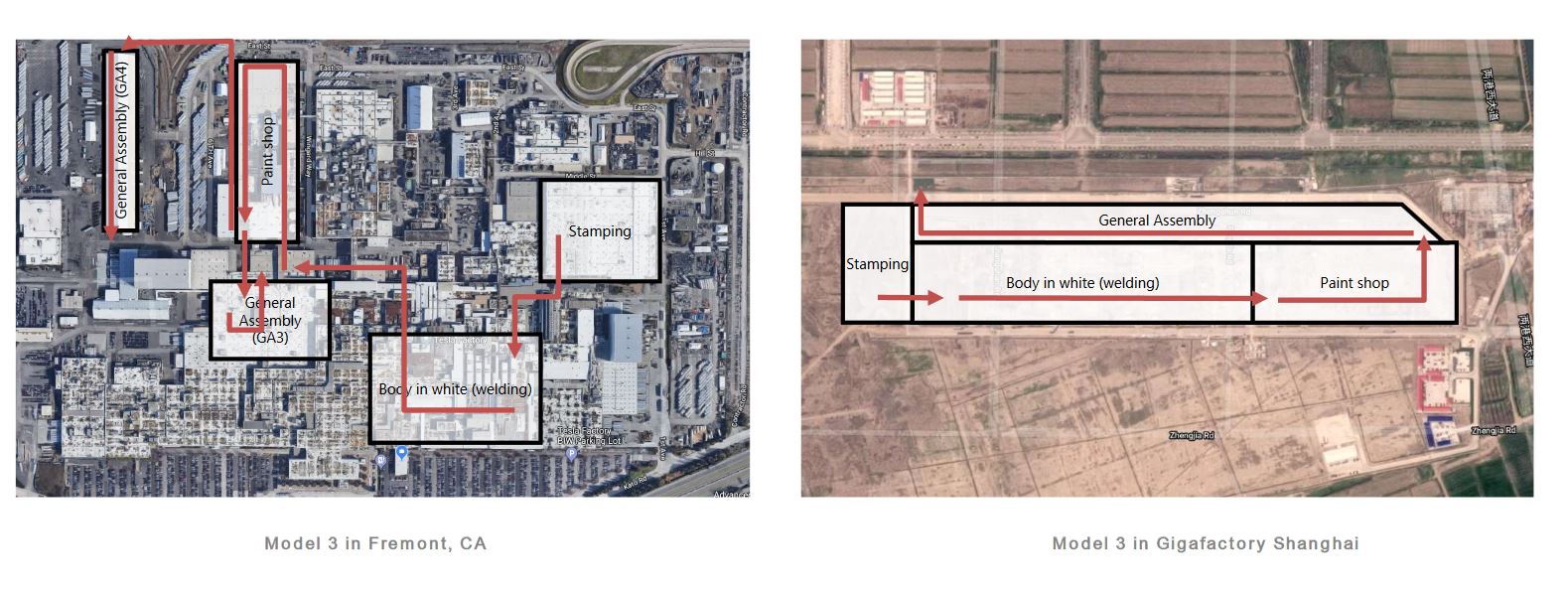In its Q4 2019 Update Letter, Tesla stated that it can comfortably deliver 500,000 vehicles in 2020, and a lot of this will be due to the Model 3 ramp in Gigafactory Shanghai and the Model Y ramp in Fremont. While Tesla’s revenue, production numbers, and cashflow were in the spotlight in the Q4 Update Letter, it was interesting to see the layout of the car factory in California next to the layout of Giga Shanghai’s production line. The flow of production in the two factories could not be any more different.
According to the electric carmaker, its Fremont factory now has a combined installed production capacity of 400,000 units for the Model 3 and Model Y. This number will hit 500,000 annually once additional machinery is installed in different production shops. Meanwhile, Tesla’s first car factory outside of the United States achieved a run rate of 3,000 vehicles per week earlier this month and is set to hit 150,000 units a year. The progress of Tesla in China is a painful truth for the electric car maker’s critics and naysayers as Giga Shanghai will play a crucial role in pushing the company towards sustained profitability.

(adsbygoogle = window.adsbygoogle || []).push({});
Tesla and its construction partner were able to turn the muddy Shanghai property into a functioning Gigafactory in record time after its initial groundbreaking ceremony. Tesla China was able to deliver its first Made-In-China Model 3s to customers exactly a year after. “Our pace of execution has also improved significantly, as we have incorporated many learnings from our experience launching Model 3 in the United States. As a result, we were able to start Model 3 production in Gigafactory Shanghai in less than 10 months from breaking ground and have already begun the production ramp for Model Y in Fremont,” Tesla wrote.
The design of the Giga Shanghai makes vehicle production look simple. It allows the smooth flow from stamping, body shop, paint shop, through the general assembly and rolls out for delivery. “We have already broken ground on the next phase of Gigafactory Shanghai. Given the popularity of the SUV vehicle segment, we are planning for Model Y capacity to be at least equivalent to Model 3 capacity,” Tesla wrote.
Learning from its experience in Fremont and seeing that it made the correct adjustments when it built the car factory in China, Tesla will likely be using a similar factory layout in Giga Berlin. This will probably result in a smooth ramp of the Model Y, which will be produced first in the European factory.
360 degree Video of assumed #GF4 building.
HQ: https://t.co/z5CuR5RRI3GEO Data: https://t.co/cBUPGEwwbd pic.twitter.com/SV5Kx3NH3L
— Giga Berlin / Gigafactory 4 (@gigafactory_4) December 23, 2019
Tesla plans to start vehicle production in Giga Berlin by July next year. Just like its factory in China, Giga Berlin will aim to produce 150,000 vehicles on its initial phase of production, eventually ramping to 500,000 vehicles per year.
Tesla has come a long way over the years. With Giga Shanghai steadily ramping up to hit its true potential and Giga Berlin to help with production in the future, Tesla has a good chance to hit goals in terms of volume growth, capacity expansion, and cash generation. And when it does, Tesla would have its Gigafactory formula to thank.

(adsbygoogle = window.adsbygoogle || []).push({});
<!–
–>
var disqus_shortname = «teslarati»;
var disqus_title = «Tesla’s Giga Shanghai formula is a trump card for the EV revolution»;
var disqus_url = «https://www.teslarati.com/tesla-gigafactory-3-shanghai-formula/»;
var disqus_identifier = «teslarati-128643»;

